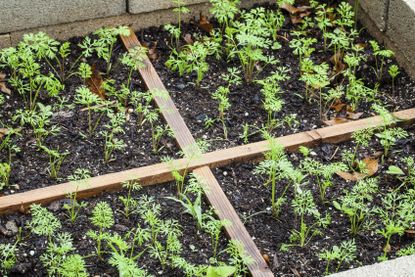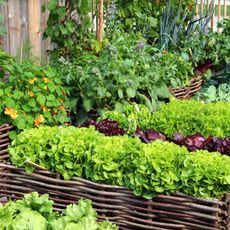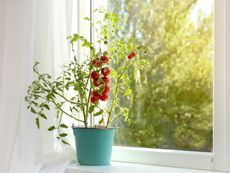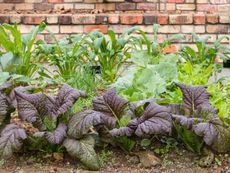Garden Layout Plans – Tips On Layout Options For The Garden


This is the year; you’re going to do it! This year you’re going to put in a vegetable garden. The only problem is you have no idea about planning a vegetable garden layout. There are several types of garden layouts, each with different advantages. In the following article, we’ll take a look at different vegetable garden layout ideas and which garden layout plans might work best for you.
Layout Options for the Garden
Before planning a vegetable garden layout, there are a few things to consider. The garden will thrive in well-draining, nutrient rich soil. It’s probably a good idea to perform a soil test to determine its composition. Once the results are in, you will know if and with what the soil needs to be amended. At this time, you can add compost, sand, humus, fertilizer or other ingredients. The garden should also be located in an area of full sun. If there is no adequate area in your landscape, vegetables can be planted in containers on a deck or patio that receives sun.
Situate the garden near a convenient water source. Young plants will need to be watered often and you don’t want the watering to become such a chore that the task is abandoned altogether. Also, the garden site shouldn’t be near established tree or shrub roots that can steal moisture from the vegetable plants.
If you have black walnut trees nearby, a lack of sun in the desired garden area or inadequate soil, try planting in raised beds. Raised beds have the advantage of providing better drainage, warm quicker so you can plant earlier in the season, and the soil stays warmer than a garden plot which will bring the crops to maturity sooner.
Types of Garden Layouts
Here are some of the most common garden layout plans for growing vegetables.
Rows
The most basic garden plan consists of a design with straight, long rows running north to south orientation. A north to south direction will ensure that the garden gets the best sun exposure and air circulation. A garden that runs east to west tends to get too shaded from the crops growing in the preceding row. Grow tall items such as corn or beans, on the north side of the garden to keep them from shading smaller crops. Medium sized plants like tomatoes, squash and cabbage, should be grown in the center. Short crops like carrots, lettuce and radishes should grow in the southern end of the garden.
Four square
Another vegetable garden layout idea is called a four square garden plan. Imagine the bed divided into four quarters, as if you have a piece of paper and have drawn a square on it and then a cross inside the square. Each square within the larger square represents a different bed. There are four categories of beds based on the amount of nutrients they need.
Gardening tips, videos, info and more delivered right to your inbox!
Sign up for the Gardening Know How newsletter today and receive a free download of our most popular eBook "How to Grow Delicious Tomatoes."
Heavy feeders like corn and leafy greens need lots of nutrients and will be included in one square bed. Middle feeders, such as tomatoes and peppers, will be in another. Turnips and carrots are light feeders that like potash in the soil and will be grown together accordingly. Soil builders are those veggies that leach nitrogen into the soil, such as peas, and will be grouped together.
This type of garden layout has the advantage of forcing you to practice crop rotation. The layout is generally from top-left and counter clockwise: heavy feeders, middle feeders, light feeders and soil builders. After harvest, plan on rotating each group to the next square the successive year. This crop rotation will help reduce pests and soil diseases.
Square foot
Square foot garden plots are generally set up in grids of 4 x 4 squares with strings or wood attached to the frame to divide the bed into equal square-foot sections. One type of vegetable is planted in each section. If vine plants are grown, they’re usually placed in the back with a trellis to allow the plant to grow up.
The number of plants per section can be calculated by dividing the lowest number of spacing inches you need into 12 inches, which makes up the individual square-foot plot. For example, the closest spacing for carrots is normally around 3 inches.
Therefore, your calculation would be 12 divided by 3, making the answer is 4. This means that you fill the square with four rows of four plants each, or 16 carrot plants.
Block
Another garden layout plan is called the block style garden layout. Also called close row or wide row planting, this method increases yields significantly over a traditional row style garden. It also suppresses weeds. The idea is to plant vegetables in rectangular beds or blocks instead of long single rows, similar to that of the square foot but with whatever measurements you need. It eliminates the need for surplus walkways, thus maximizing premium gardening space.
The plants are grouped together densely and, therefore, need fertile, well-drained soil rich in organic matter. They will need fertilization due to the high density. Try not to overcrowd the veggies when using this method. This reduces air circulation and can result in disease. The bed should be 3-4 feet wide and any length desired. This width makes it easy to reach into the bed to weed, harvest or replant. Walkways should be minimal and about 18-24 inches across.
Mulch the walkways with grass clippings, wood chips or another organic mulch. Plant crops with equal space between adjacent plants in both directions. For instance, space a carrot patch on a 3- by 3-inch center – visualize the layout as running rows spaced 3 inches apart across the bed with thinned carrots within the row to 3 inches. A 24-foot long traditional garden row of carrots will fit into a 3-foot by 2-foot bed.
Vertical
Growing vegetable gardens vertically is yet another option. These gardens are designed for people having little to no traditional garden space. Rather than planting in your typical garden bed, you take advantage of vertical space, growing plants along trellises, hanging baskets or even upside down.
There are even stackable containers available that allow you to grow a number of plants in one area by simply stacking the pots onto one another like a tower. Speaking of which, planting towers are another vertical option for growing plants and popular for potatoes.
Raised bed/containers
Again, for those having little space or even inadequate soil, planting veggies in raised beds or containers is a great alternative. With this layout option, the sky is the limit, as you have the flexibility in moving the garden around and making use of all available space, including vertical areas.

Amy Grant has been gardening for 30 years and writing for 15. A professional chef and caterer, Amy's area of expertise is culinary gardening.
-
 "My Worst Mistake" – Gardeners Share 10 Hard-Learned Lessons
"My Worst Mistake" – Gardeners Share 10 Hard-Learned LessonsGardeners never stop learning, and sometimes our mistakes are the best teachers. But why not save time and heartache by learning from other gardeners' failures?
By Melanie Griffiths
-
 Crops for Urban Growing: 8 Edible Plants For Urban Gardens
Crops for Urban Growing: 8 Edible Plants For Urban GardensUrban edible gardening lets your yard do double duty of beauty and practicality. Have fun combining edible plants with ornamentals.
By Teo Spengler
-
 How Many Vegetables To Plant Per Person For A Year
How Many Vegetables To Plant Per Person For A YearGauging how much to plant in a vegetable garden can eliminate waste while still producing enough for your family. Click for more.
By Bonnie L. Grant
-
 13 Perennial Fruits And Vegetables You Only Have To Plant Once
13 Perennial Fruits And Vegetables You Only Have To Plant OnceLooking to set it and forget it? Find out which fruits and vegetables can be grown as perennials.
By Laura Miller
-
 11 Edible Plants For A Year-Round Garden In A Bucket
11 Edible Plants For A Year-Round Garden In A BucketWant to know how to grow food inside your house and which foods do best indoors? Click here to learn all about it.
By Bonnie L. Grant
-
 Frost Tolerance Of Vegetables From Least To Most Hardy
Frost Tolerance Of Vegetables From Least To Most HardyHow cold can vegetables tolerate? Knowing which veggies will survive frosts and freezes is essential for the success of your garden. Click here for more.
By Laura Miller
-
 Best Vegetables To Pickle Straight From The Garden
Best Vegetables To Pickle Straight From The GardenPickles aren’t limited to just cucumbers. Read on for tips on pickling your fresh veggies.
By Amy Grant
-
 Benefits Of Planting In Fall Vs. Spring Vegetable Plots
Benefits Of Planting In Fall Vs. Spring Vegetable PlotsLearn why some vegetables do better if you plant them in fall instead of spring.
By Laura Miller
-
 Interplanting Vegetables In The Fall Garden
Interplanting Vegetables In The Fall GardenLearn all about the benefits of interplanting vegetables for your fall garden.
By Laura Miller
-
 Best Vegetables For Growing In Perlite
Best Vegetables For Growing In PerlitePerlite is a natural growing medium that comes from super-heated volcanic glass. In some cases, it works better than soil. Read on for more info.
By Laura Miller